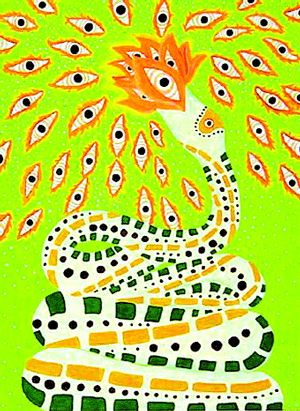Fertility, origins and native deities inspire Tamara Gonzales’ paintings
In an inspired statement that accompanies Tamara Gonzales’ exhibition “Seed,” the artist touches on a concert this past summer by Donovan and the notion that plants can talk, then more pessimistically wonders if Americans are really interested in dying free.
“It was looking more and more likely that they would rather die full,” she writes.
Gonzales cites a misremembered image by Joan Miró as the beginning of her recent series of paintings. She recounts painting a large blue dot that multiplied, becoming what she variously interprets as planets, suns and flowers, as well as the souls of war dead.
Most of the paintings resemble amoebas sprouting nippled petals, like Cybele, also known as Artemis, the many-breasted Anatolian fertility goddess. Gonzales has visited Selcuk, Turkey and seen the multi-breasted luminous sculptures that were once part of the Artemision temple, one of the Seven Wonders of the World. The extant stone deities seem to possess infinite fecundity. This goddess, transmogrified by early Christians into the Virgin Mary, was the offspring of a sleeping Zeus ejaculating on the ground. For these paintings of “fertility,” Gonzales uses a viscous, white enamel, a sort of lacteal sperm, in homage. Gonzales painted faces in the dots, then painted them out.
Gonzales’ influences are gleaned from Mexican “Day of the Dead” festivities, as well as time she spent in India.
“I remembered that widows wear white in Varanasi,” she writes.
Her Latin American heritage is evident, as is her Buddhism, and a decorative impulse derived from the Christmas decorations found around Williamsburg, Brooklyn and the Catskills. Gonzales’ use of cheap novelty merchandise lends irony to her work’s mythic perspective in that a global language describes these items. The landscape of the populated world is half-14th Street and half-dirt road. This group of cosmic hippie paintings is, in fact, giving us a very big picture of our historical moment. It’s a wonderful show and well timed for a season of pagan, tribal, religious and consumer celebrations.


































